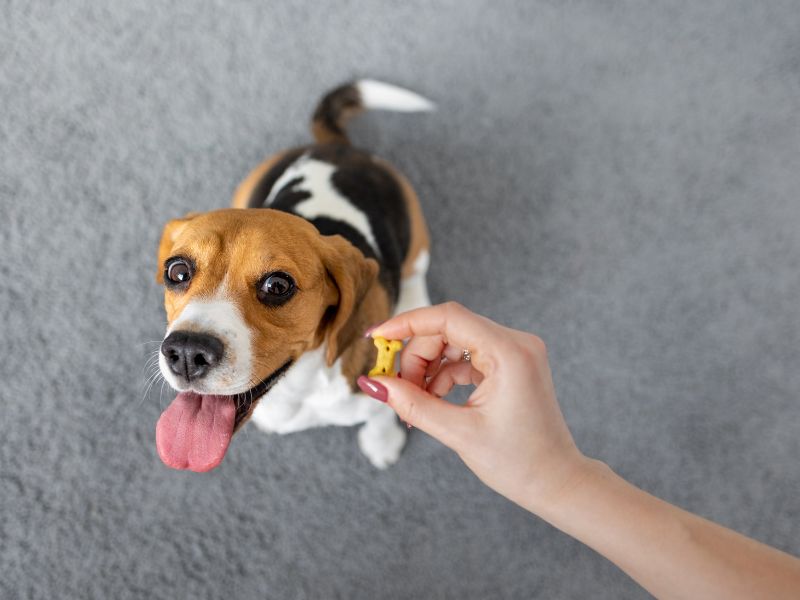It’s true; dogs are like humans in many ways. One similarity we share with our furry best friends is taste buds that allow us to taste different flavors. But when it comes to dog taste buds, there are a lot of differences as well.
It’s no secret that most dogs live to eat. Food is a joy and often makes them do a little happy dance whenever you see them preparing it. Sometimes you wonder if they even taste it because they seem to inhale it so quickly, but for all intents and purposes, food is a pleasure for dogs.
But why? Is it because they find it just as delicious as we humans do? Do they have similar preferences for tastes like we do?
What are dog taste buds like?
We already know that the dog’s olfactory system is far more sensitive and complex than ours. A dog’s sense of smell is thought to be more than a thousand times stronger than a humans. They can often tell food is around even if they don’t see it or hear any evidence that would suggest that to be the case.
So it would stand to reason that dog taste buds would probably be as sensitive and complex too, right? That sensitivity would explain why they go nuts at mealtime.
The science suggests otherwise, though. It turns out that while humans have about 10,000 taste buds, dogs have closer to 1,700, give or take. Their sense of taste is actually less developed and sensitive than ours. In fact, it’s fairly debated as to how many types of flavors dogs can even detect. Humans are thought to be able to detect five different types of tastes: bitter, salty, sour, sweet and umami, or savory.
Most experts agree that dogs also have dog taste buds that detect bitter, salty, sour and sweet tastes but have a much lower sensitivity to sweet and a higher sensitivity to bitter tastes. Research implies that this could be an evolutionary adaptation to their natural carnivorous diet–not a lot of need for a strong sense of taste for sweets, but avoiding bitter tastes could protect them from poisons and toxins in the wild.
Additionally, dogs have a special taste bud that detects and helps them taste water. This is also pivotal for their survival, considering they are thought to be made up of about 70% water. This water receptor helps defend them against dehydration.
Picky, Picky
Dogs can be just as picky about their food as humans, though. They can have preferences just as humans do, and a lot of the time you see a ‘picky’ dog, it’s because their taste buds are working just as ours do with regard to what we’d rather eat. Though dogs don’t have the same sensitivity to sweets as humans do, they still tend to like sweets as much as humans and that’s why so often you’ll find sweeteners in treats and even dog foods. It’s important to read labels, as those sweeteners are typically needless calories.
That said, their umami taste receptor, or savory/meaty receptor, tends to win out as this is the most prevalent taste in protein-rich foods that keep dogs healthy and happy. Their dog taste bud tendency to favor their savory receptors, combined with an olfactory system that is a thousand times better than a human’s is the number one reason they show up at the thought of something meaty or meaty tasting and sit pretty waiting for a bite.
Are dog taste buds the same size as a human’s?
Dog taste buds are larger than human taste buds. Again, because ancestrally, dogs had to have high-protein diets to survive, they needed to be able to seek those foods out. Meats typically carry the highest protein levels, and studies suggest that a dog’s savory/umami receptors are the largest a dog has. Dogs have had to rely on themselves for survival until domesticated, and large taste buds in dogs and their water receptors have kept them alive and growing.
That said, some diets of today–mostly dry kibble and/or table scraps–may not fully support all the nutrition dogs need to stay healthy, and supplementation is essential.
Why should Bernie’s Perfect Poop be part of every meal for dogs?
Whatever it is that makes dogs want to eat (or not eat, as the case may be for some ‘picky’ dogs), their diet is important. Dry kibble is typically made from processed ingredients under high heat and pressure and that can take out many of the essential vitamins and nutrients your dog needs. Low moisture in dry kibble can also take its toll on kidney function and overall health, so ensuring plenty of water is important for dogs.

Some dogs just get tired of the same food every day. Much like we may get bored with the same bowl of cereal every morning, they may have palatability issues they deal with that makes eating more monotonous, and that puts them at risk of not getting enough nutrition. Even if your dog is on a fresh/human/raw food diet, it is important to ensure they’re getting the right mix of fiber and digestive enzymes to best aid digestion.
And that’s what Perfect Poop does. We created Perfect Poop to give the best gut health to our dogs, Bernie and Lady. Perfect Poop is a 4-in-1 combination of fiber, prebiotics, probiotics, and enzymes that allow your dog the best gut health. A digestive tract that moves food through appropriately, breaks food down for optimal nutrient absorption and helps their microbiome flourish with beneficial bacteria is one that helps ensure the best health for our dogs and the same goes for yours. We believe the key to happier, healthier lives for dogs begins in their gut, so no matter what they’re eating (or prefer the taste of), Perfect Poop with every meal ensures they’re getting the maximum nutrition they can.


